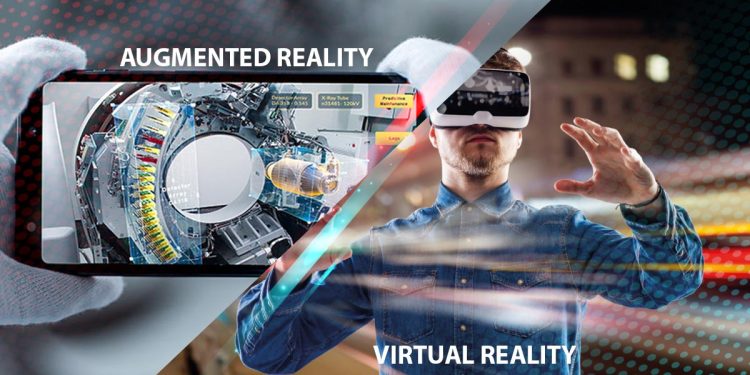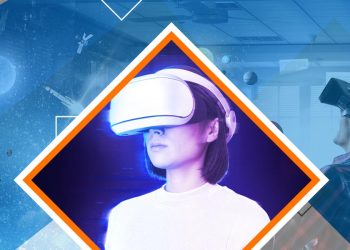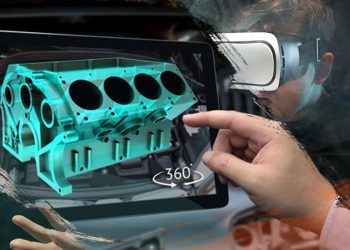Augmented reality and virtual reality offer ground-breaking possibilities in the gaming, marketing, branding, and education industry. Both the technologies focus on blending the real and virtual world, just in different proportions.
However, to have an enriched experience of both technologies, a comparison between augmented reality and virtual reality is necessary. End users can easily get confused between these two, but they have major differentiating factors that set them apart.
This article will uncover the facts in augmented reality vs. virtual reality comparison. Go ahead and experience the best of both worlds.
Understanding the Basics of Augmented Reality Vs. Virtual Reality
Augmented reality focuses on merging brilliant virtual elements in the real world.
The most outstanding example is the scoreboard during sports tournaments’ live telecasts. The three-dimensional texts and numbers you see from the ground result from augmented reality.
AR does not create an illusional virtual world. Instead, it incorporates digital components into the actual scenario, easily accessible through mobile phones and some other devices.
Unlike AR, virtual reality creates an imaginary world for you to have a unique experience.
Before playing a cricket match, the VR devices you wear give you a glimpse of virtual reality’s magic. It can be called a parallel world generated by computational techniques. Though one cannot enjoy virtual reality’s experience without sensory devices like headgears or gloves.
You can get a clear comparison in the next section, which has a concise comparison table between augmented reality vs. virtual reality.
Augmented Reality Vs. Virtual Reality: Brief Comparison Table
Below is a comparison table to help you understand the fundamental differences between augmented reality and virtual reality.
| Augmented Reality | Virtual Reality | |
| 1 | Adds virtual elements into the real world | Creates an immersive virtual experience |
| 2 | The user controls their senses | The system guides sensory controls |
| 3 | It is 75% real and 25% virtual | It is 75% virtual and 25% real |
| 4 | The user is partially involved. | The user is completely immersed in the technology. |
| 5 | It is used to enhance both real and virtual world experience | It creates realistic experiences artificially |
| 6 | Requires top-notch bandwidth and connectivity for proper functioning | Requires standard bandwidth for practical experience |
| 7 | Does not require any extra device | Mandatory to use sensory devices and intelligent wearables for the best experience |
| 8 | It is oriented to the user’s action | It stimulates user action |
There is a list of examples in the next section to understand the practical differences while comparing augmented reality vs. virtual reality.
Practical Examples of Augmented Reality vs. Virtual Reality
There is no denying that augmented and virtual reality have many unique applications and benefits. It has helped solve many practical problems by making the details accessible and maintaining transparency in the process.
Hence, before we dive deep into the technical comparison of augmented reality vs. virtual reality, let us understand the practical examples of its usage.
Below are some augmented reality applications that one can use to solve everyday problems.
- Makeup Apps: One of the most popular features in cosmetic brands’ websites is AR integration to try on new makeup virtually. Now, it is easier to choose the shade of lipsticks, eyeliner, and eye makeup palette with the help of augmented reality.
- Sports Training: It has become easier to track sports performance and body dynamics by wearing simple devices. This provides real-time statistics and improves physical training.
- Ikea Place: It is a beautiful app that allows you to try out furniture placements in your home using AR. While live streaming your room, you can virtually place the 3D furniture element and see how it looks.
- Repairing Support: This is one practical application that allows you to repair a device or equipment with step-by-step instructions. AR integration points out the parts where one has to operate and helps the technician resolve the issue.
Now, let us look at some fantastic examples of virtual reality beyond gaming and entertainment.
- Risk-Oriented Training: Virtual reality is actively used to train people in the fire safety department, building rescue operations, and tower rescue. This allows the trainees to learn the skills without compromising their safety.
- Flight & Car Practice: VR has made it easier to practice flight and driving sessions by integrating the mechanical parts with VR devices and graphics. One can easily opt for these sessions, which also helps while appearing for examinations.
- Designing: Many architects are using virtual reality-based applications to design homes. This also allows builders, promoters, and clients to take a walk through the design and experience the project before it is ready.
After an exciting tour of the conceptual comparison between augmented reality and virtual reality, let us look at the technical part. The following section comprises some significant elements that make up the world of AR and VR.
The Technical Aspects of Augmented Reality vs. Virtual Reality
The technologies associated with altering reality have immense scope in user experience and marketing. While entertainment is just the tip of the iceberg, 90% of revenue-generating companies also leverage their augmented reality and virtual reality technology stack.
This part of the article will discuss the various components contributing to the surge of altered reality technologies. Below are some major contributing factors to both augmented reality and virtual reality.
i). Input Device:
Augmented reality is pre-built so that the user can use it on the go. Even when smartphones and tablets are available, AR can be used with just a few clicks. This technology allows quick interaction within the virtual space without making it a cumbersome task.
ii). Sensors:
This is a component that has a vital role to play in processing all the data. AR is generally a motion-based technology, and it requires accurate motion sensing. Hence, the device needs an accelerometer, GPS sensor, and digital compasses as essential support.
iii). Processor:
Accurate processing requires AR technology to place or incorporate the correct object in the right place. The mix of the virtual and real worlds must have quick data navigation.
iv). Camera:
It is the backbone of augmented reality because the camera is the canvas for placing the 3D elements in the space. Hence, the camera detects the space and allows the technology to place the elements as and when required.
v). Display:
Both display and camera go hand-in-hand to altered reality space. This display can be on a mobile, wearable device, head-up device, and other possible devices that might emerge in the future.
Apart from understanding the technical components of AR and VR, it is essential to grasp the software integrations that add life to it. Below is a list of software and algorithms that make AR and VR what they are today.
vi). Rendering and Registration:
This involves a three-dimensional graphic presentation of an element that will be fixed in the real-world canvas virtually. After rendering the image, it will be simulated to fit inside real-world coordinates based on the registered recognition data in the system.
vii). Content Management:
The database works like a directory for all the 3D objects and elements. It is a back-end technology that utilizes cloud computing for data storage and management.
viii). Development System:
The development software works like a creator for everything AR and VR offer. It is a mix of human resources and technology stack that works together to assemble all the components of augmented reality and virtual reality.
ix). Interface:
This is the connection between the product and the end-user. It is responsible for presenting the result of the development team to the user in an effective manner.
After understanding the hardware and software components of augmented reality vs. virtual reality, it is time to move ahead and see from a business perspective. So, it is evident that the technology is undoubtedly awe-inspiring but is it feasible for businesses?
In the next section of this article, we will be discussing the advantages and challenges of incorporating this technology. Keep reading to understand this better.
Comparing Pros: Augmented Reality vs. Virtual Reality
Although this needs no briefing, it is essential to give a deeper insight into augmented and virtual reality pros. Below is a list of advantages that augmented reality offers.
- Wide variety of applications in different industries
- User-centric technology to enhance the experience and knowledge
- There is always a scope for constant improvement
- Offers an innovation-based solution to the end-user
- Enhances the accuracy of product selection in e-commerce
- The experience is shareable that also enables third-party to enrich their knowledge about the niche
Below is a list of advantages one can get from virtual reality.
- An immersive experience in the education and entertainment sector
- The end-users don’t feel isolated as the interface remains interactive at all times
- It creates a realistic experience that is created virtually
- Convenient for next-generation educational institutions leveraging AI, VR, and virtual learning
- Allows the end-user to gain a real-time outlook of the desired environment, such as commercial projects
Like every coin has two sides, so does altered reality. It is necessary to look at some disadvantages of augmented reality vs. virtual reality in the future.
Comparing the Cons: Augmented Reality vs. Virtual Reality
Looking at the current scenario of augmented and virtual reality technology, it is apparent that they are at an infant stage. Hence, the technology is impressive, but businesses are still skeptical about leveraging their technology.
However, there are some valid reasons for businesses to give a second thought to this technology. Below is a list of cons involved in augmented reality technology.
- AR is not cost-effective for all types of businesses
- There are still questions about AR’s privacy protection policy
- Dependence on augmented reality can cause health issues in the long run
- AR-based devices are still in a testing phase which makes them less efficient
In contrast to augmented reality, let us look at the cons of virtual reality below.
- There is a lack of efficacy when it comes to training via virtual reality
- Has some ethical issues as VR promotes the idea of escapism indirectly
- Not accessible to all the people equally
- It is 75% virtual and takes away the authenticity of real experiences
Sure, the technology is fancy and has raised many eyebrows, but some questions still need clarification. Therefore, the last part has some frequently asked questions about augmented reality and virtual reality.
Frequently Asked Questions
1. Does AR & VR technology have any side effects on the human mind?
Augmented reality and virtual reality are impressive technologies that keep people hooked to their gadgets. Ultimately, these technologies affect the user’s mental health in many ways. Controlled usage and supervision are advised for the mindful application of these technologies.
2. What are the job opportunities in AR & VR industry?
There is an immense requirement for a content management team and research analysts. Hence, many companies are leveraging AR & VR and are on the lookout for software developers, graphic designers, software maintenance executives, and project managers.
3. What challenges can a business face while leveraging AR & VR?
Some of the current challenges for businesses involve device handling and management, privacy protection, and building a sustainable business model after integrating this technology.
4. What is expected from altered reality technology in the coming years?
Apart from games and entertainment, AR & VR application will involve practical training in the education sector, examination, and integration with artificial intelligence.
Final Words
Therefore, it would be wrong to assume that augmented reality and virtual reality are two separate things because the diversions of the same technology can work together.
The sole purpose of this technology is to create a fictional reality for the user and elevate the experience of different industries. What started as a game and entertainment now has applications in large commercial projects, education, and the healthcare sector.
This has set an example of how lines are blurring between the real and imaginary worlds. The best part is that consumers are actively engaging with the technology, which is why it finds applications everywhere. The road ahead has a lot of innovation and adventure to offer.
Gracie Johnson is a Senior Content Writer at MyTechMag. She is an enthusiastic learner and loves to explore all the areas of technology.








